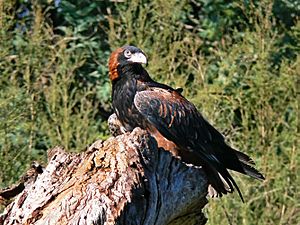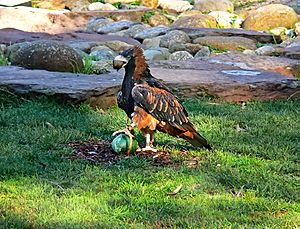Black-breasted buzzard facts for kids
Quick facts for kids Black-breasted buzzard |
|
|---|---|
 |
|
| Conservation status | |
| Scientific classification | |
| Genus: |
Hamirostra
|
| Species: |
melanosternon
|
| Synonyms | |
|
|
The black-breasted buzzard (Hamirostra melanosternon) is a large bird of prey found only in mainland Australia. It was first described by John Gould in 1841. This bird is part of the Accipitridae family, which includes hawks and eagles. It is closely related to the square-tailed kite. The buzzard is a clever hunter, famous for its special skill: cracking open eggs! You can find this species in many parts of its home range.
Contents
About the Black-breasted Buzzard
The black-breasted buzzard is one of Australia's biggest birds of prey. It is larger than the little eagle but smaller than the huge wedge-tailed eagle. An adult buzzard stands about 51–61 cm tall, including its short, square tail. When its wings are spread, they can reach 147–156 cm across. This makes the bird look very distinct in flight, with its long wings and sturdy body.
What Does the Buzzard Look Like?
Male and female buzzards look very similar. However, the female is usually a bit bigger. Adult buzzards have striking black feathers on their bodies and wings. From below, you can see thick white patches near the ends of their wings. From above, their black feathers are mixed with a rich, mottled red color on their back and shoulders.
Young buzzards are pale brown. They get more dark streaks as they grow older. Baby buzzards have soft, white, hair-like down on their heads. You can sometimes tell individual birds apart in flight by broken feathers. When they are perched close, you might notice small differences in the red color on their backs.
What Does the Buzzard Sound Like?
The black-breasted buzzard often makes a harsh, yelping call. It sounds like a short, sharp "yap" or "yelp." Female buzzards also make a soft, drawn-out wheezing sound. They use this call to ask their mate for help. This could be for building the nest, finding food, or protecting their home. Young buzzards also use a wheezing call to ask their parents for food.
Where Do Black-breasted Buzzards Live?
The black-breasted buzzard lives across northern and inland Australia. It prefers areas that get less than 500 mm of rain each year. You can find them in north-eastern South Australia, north-western New South Wales, northern Queensland, the Northern Territory, and north-western Western Australia. They do not live in Victoria, the Australian Capital Territory, or Tasmania. These places are too wet and have cooler climates.
Buzzard Homes and Habitats
Buzzards live in both wooded and open areas. They are most often seen in riparian forests. These are forests along rivers and creeks. They also like tall, open woodlands surrounded by medium-dense shrubs. One study found that they especially like open woodlands with River Red Gum trees.
What Do Black-breasted Buzzards Eat?
The black-breasted buzzard hunts many different animals. Its diet includes reptiles, small mammals, and birds. They also raid bird nests to steal eggs and baby birds, even from other birds of prey! Buzzards are not known as super-skilled hunters. They often eat dead animals (carrion) found along roads or creek beds.
How Do Buzzards Hunt?
Buzzards use different ways to find food. They might soar high in the sky over low plants. Sometimes, they hunt together with other buzzards. They also watch for prey from high perches. When they spot something, they might drop, pounce, dive, or glide to catch it.
The black-breasted buzzard is famous for its special hunting trick. It uses stones to crack open the eggs of large ground-nesting birds. These include the Emu, Brolga, and Australian bustard. The buzzard either drops a stone onto the egg or throws it. This breaks the egg open so the buzzard can eat what's inside. They can also use their strong beaks to crack eggs directly.
Black-breasted Buzzard Families
Black-breasted buzzards usually mate for life. They form strong pair-bonds. They build their nests in very tall and wide trees. These trees are often larger and stand out from others nearby. The trees can be dead with bare branches or alive with leaves. Nests are usually placed high up in the tree forks.
Building a Home and Raising Chicks
Both parents help build the nest. They often work together. Nests are made from dead sticks and leafy branches. They gather materials from the ground or break them off trees. They carry these pieces to the nest with their feet or beak. Buzzard nests are very large, even bigger than those of the wedge-tailed eagle!
Buzzards lay their eggs from August to October. Breeding seems to start when days get longer. More food from rainfall also helps. A female usually lays two eggs, about 8–13 days apart. The eggs hatch after 32–38 days. Baby buzzards stay in the nest for about 68–73 days. They fledge (learn to fly) around December. The female stays at the nest most of the time. The male hunts and brings food. Usually, only one chick from each nest survives to fledge each season.
Why Do They Add Green Leaves to the Nest?
Buzzards often add fresh, leafy branches to their nests. These are separate from the main nest structure. Scientists think this "greenery" might help keep the nest clean. It could fight off parasites and germs. Other ideas are that it helps with courtship or chick development. This behavior is seen in many bird species worldwide, but we don't fully understand it yet.
Protecting the Black-breasted Buzzard
The IUCN Red List currently lists the black-breasted buzzard as a species of Least Concern. This means it is not in immediate danger globally. However, it is listed as Vulnerable in New South Wales and Rare in South Australia. Some studies suggest it is a bird that needs special attention in western New South Wales. The total number of black-breasted buzzards in the world is not certain. Estimates range from 1,000 to 10,000 birds.
Why Are Their Numbers Declining?
Many Australian birds of prey, including the black-breasted buzzard, have seen their numbers drop. This has happened since Europeans settled in the late 1700s. In some areas, the buzzard disappeared as early as the 1930s.
Reasons for this decline include:
- Changes to the land: Large areas have been changed for farming and clearing native plants.
- Overgrazing: Too many farm animals, wild animals, and kangaroos eat too much vegetation.
- Different fire patterns: Fires happen differently now than they used to.
- New predators: Wild house cats and red foxes hunt native animals.
- Loss of traditional practices: Aboriginal hunting and land management practices have stopped.
- Droughts: Long periods of dry weather in the 1900s and 2000s made things worse for birds.
Other Threats to Buzzards
Birds of prey can also get sick from eating poisoned prey. This happens when humans use poisons to control pests. Illegal egg collection and shooting have also harmed some Australian raptors.
Climate change is another big worry. More droughts in dry areas of Australia threaten many raptors. The black-breasted buzzard eats many different things, including dead animals. This might help it survive droughts when many large animals die. However, buzzards prefer to live and nest near creeks and rivers. These areas dry up during droughts, which can harm their ability to reproduce and survive. More frequent and intense wildfires also destroy the large trees they need for nesting.
How Can We Help?
To protect the black-breasted buzzard, we need to protect its habitat. This means keeping the areas where they live safe. We also need to plant new trees where habitats have been lost. This effort needs everyone involved, including land managers and local communities. Protecting the buzzard helps protect all the amazing plants and animals in Australia's dry regions.
[2] NSW Government - Threatened Species Profile
Images for kids
See also
 In Spanish: Milano pechinegro para niños
In Spanish: Milano pechinegro para niños





